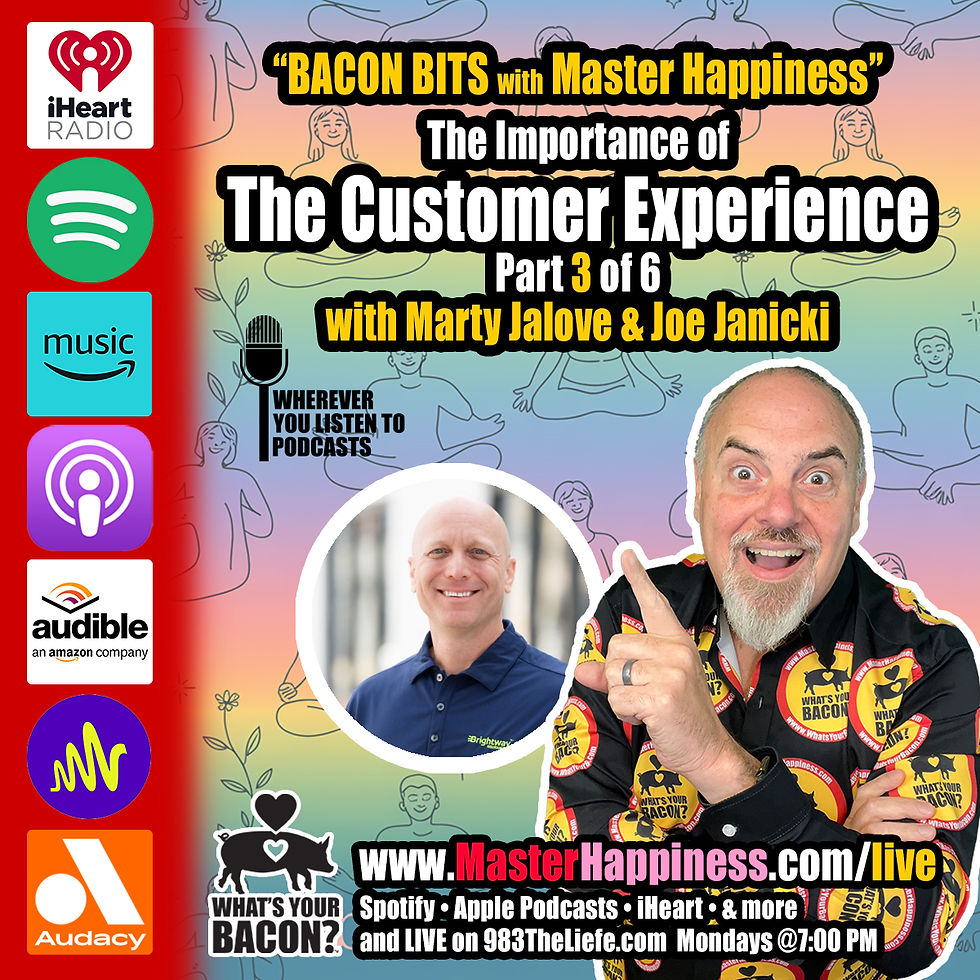Part 3 of 6: The Customer Journey
- Marty Jalove

- Jul 30
- 7 min read
Picture this: You walk into a business, and everything just feels right. The space is welcoming, the staff anticipates your needs before you even ask, and the entire experience leaves you thinking, "I can't wait to come back." That's not luck, that's a carefully crafted customer journey at work.

Join Marty Jalove, Master Happiness
with special Guest:
Follow us at: www.MasterHappiness.com/live or “Bacon Bits with Master Happiness” on Apple Podcast, Spotify, Amazon Music, Audible, iHeart Radio or wherever you listen to your favorite podcasts.
See it on YouTube
Most business owners focus so intensely on what they want to achieve that they forget to think like their customers. They concentrate on sales numbers, profit margins, and operational efficiency while missing the most crucial element: the human experience. The customer journey isn't just about that first impression, though it certainly starts there. It's about every single touchpoint, every interaction, and every moment that shapes how people feel about your business.
The customer journey is the complete experience your customers have with your business, from the moment they first discover you to long after they've made a purchase. It's not a single transaction or a one-time interaction. Instead, it's an ongoing relationship that evolves over time, and when done right, it transforms casual buyers into loyal advocates who can't stop talking about you.
Think of it like taking someone on a guided tour of your business values. You're not just showing them your products or services, you're demonstrating who you are, what you stand for, and why they should trust you with their time and money.
The BACON Method: Five Essential Ingredients for Customer Journey Success
Every great customer journey needs the right ingredients, and like everything else in business and life, it's better with BACON:
B - Building a strong first impression
A - Anticipating customers' needs
C - Customizing the journey
O - Optimizing every interaction
N - Nurturing relationships beyond the purchase
Let's dive deeper into each element and discover how they work together to create experiences that keep customers coming back.

Building a Strong First Impression: The Foundation of Everything
Your first impression starts before customers even walk through your door. It begins with your building's exterior, your landscaping, and yes, even whether there's litter in your parking lot. Here's the truth that many business owners struggle to accept, you live inside the glass jar of your business every single day, and you stop seeing what's actually there.
That chipped paint you've been meaning to fix. The slightly dirty carpet you walk over daily. The cluttered reception area that "isn't that bad." Your customers see all of it with fresh eyes, and they're making judgments within seconds.
The solution is surprisingly simple but requires brutal honesty. Either hire someone who's never been to your business to walk through and give you feedback or force yourself to see your space as if you're experiencing it for the first time. Look at everything, the rugs, the plants, the windows, the corners. Are things clean, neat, organized? How does your team present themselves?
Remember Mary Kay Ash's powerful training principle: imagine every single person you meet has a sign around their neck that says, "Make me feel important." This mindset shift changes everything. When your employees understand that their job isn't just to complete tasks but to make people feel valued, the entire atmosphere transforms.
Your first impression isn't just visual, it's emotional. When someone walks into your business, they should feel welcomed, valued, and confident they've made the right choice.
Anticipating Customer Needs: Reading Between the Lines
The most successful businesses don't just respond to customer requests, they anticipate them. This requires a deeper understanding of what people are thinking, feeling, and likely to do at each stage of their journey with you.
Start by training your team to ask three critical questions about every customer interaction:
What is this customer THINKING right now?
How does this situation make them FEEL?
What are they likely to DO with this information?
This framework helps your team move beyond simply following scripts to truly understanding human behavior. When you know that a first-time customer might feel uncertain, you can proactively address those concerns. When you recognize that someone seems rushed, you can streamline their experience without making them feel ignored.
The key is role-playing and consistent practice. Just like firefighters train repeatedly so their responses become instinctive during emergencies, your team needs to practice handling various customer scenarios until exceptional service becomes second nature.
Train your people to recognize the difference between customers who want detailed conversations and those who prefer quick, efficient service. Some people want to chat and build relationships; others want to get in and out as quickly as possible. Your team should be skilled enough to identify these preferences within the first few moments of interaction.
Customizing the Journey: One Size Fits Nobody
We live in an era where customers expect personalized experiences. Seventy-three percent of consumers say they expect companies to understand their unique needs and preferences. The good news? Technology has made customization more accessible than ever, regardless of your business size.
Start by mapping out every touchpoint in your customer journey. Write it all down, create a visual flowchart, or use a whiteboard, whatever works for your thinking style. You'll likely discover redundancies, unnecessary steps, or opportunities to offer customers choices in how they interact with you.
For example, when someone contacts you for information, you might offer multiple options: "We can handle this over the phone in about 12 minutes, or I can send you a link to complete this at your convenience. What works better for you?" This simple choice lets customers feel in control while ensuring you can deliver efficiently either way.
The most important aspect of customization is setting clear expectations. Tell your customers exactly what their journey will look like: "Here's what we're going to do together. First, we'll gather this information, then my team will analyze your needs, and I'll call you back tomorrow at 2 PM to discuss your options." When people know what to expect, they're more likely to have a positive experience.
Optimizing Every Interaction: The Pursuit of Continuous Improvement
The world changes daily, and your customer journey should evolve with it. What worked last year might feel outdated today. Technology advances, customer expectations shift, and new tools become available that can streamline your processes.
Regular optimization means constantly asking: "How can we make this better for our customers?" This might involve using new software to gather information you previously had to ask for, implementing AI tools to handle routine inquiries, or simply rearranging your physical space to create better flow.
The key is involving your entire team in this process. Your front-line employees interact with customers daily—they often have the best insights into what's working and what isn't. Create regular opportunities for them to share observations and suggestions. Make improvement a team effort, not a top-down mandate.
Remember, optimization isn't just about efficiency, it's about removing friction while maintaining the personal touch that makes customers feel valued. Sometimes the most efficient process isn't the most human one and finding that balance is crucial.
Nurturing Relationships Beyond the Purchase: The Long Game
The customer journey doesn't end when someone buys from you, that's when the real relationship begins. Too many businesses focus all their energy on acquiring new customers while neglecting the goldmine of existing relationships they already have.
Think about your favorite businesses. What keeps you coming back isn't just their products or services; it's how they make you feel. They remember your preferences, check in on your satisfaction, and continue to add value to your life even when you're not actively buying.
This nurturing doesn't require grand gestures. Sometimes it's as simple as a genuine "How did everything work out for you?" follow-up call or remembering personal details that show you see customers as individuals, not just transactions.
The goal is to move customers through what we call the "Huh-Hmm-Hey" progression:
Huh: "Who are these people?" (Initial awareness)
Hmm: "Maybe I want to do business with them" (Growing interest)
Hey: "I love these guys!" (Loyal advocacy)
Only when customers reach that "Hey" stage—when they genuinely love doing business with you, should you feel comfortable asking for referrals. At that point, they're not just customers; they're part of your extended business family.
Making Every Moment Matter
The customer journey isn't just a business strategy—it's a philosophy about how you treat people. It's about recognizing that behind every transaction is a human being with hopes, concerns, and the desire to feel valued.
Start small but think big. Maybe it's offering free water to everyone who walks through your door (seriously, this costs almost nothing and makes a huge impression). Perhaps it's training your team to walk customers to what they're looking for instead of just pointing in the general direction. Or it could be as simple as ensuring every interaction includes genuine enthusiasm and energy.
The businesses that master the customer journey don't just survive—they thrive. They create communities of loyal customers who become their best marketing asset. They build sustainable competitive advantages that can't be easily copied because they're based on authentic human connections.
Remember, you're not just mapping out a process—you're creating experiences that people will remember, talk about, and return to again and again. In a world where customers have endless choices, the journey you create might be the only thing that sets you apart.
The question isn't whether you can afford to focus on the customer journey. The question is whether you can afford not to.
Part 3 of 6: The Customer Journey
To learn more about The Customer Journey with BACON! go to: www.MasterHappiness.com/live or “Bacon Bits with Master Happiness” on Apple Podcast, Spotify, Amazon Music, Audible, iHeart Radio or wherever you listen to your favorite podcasts.
Or catch us LIVE on "BACON BITS with Master Happiness" on 983thelife.com, Monday Night at 7:00 PM and start making your life SIZZLE!
Marty Jalove of Master Happiness is a Company Coach, Business Consultant, and Marketing Strategist that helps small businesses, teams, and individuals find focus, feel fulfilled, and have fun. He helps businesses struggling with communication issues between co-owners, staff, and customers grow a happier and healthier business.
Master Happiness stresses the importance of realistic goal setting, empowerment, and accountability in order to encourage employee engagement and retention. The winning concentration is simple: Happy Employees attract Happy Customers and Happy Customers come back with Friends.
Want to learn more about bringing more happiness into your workplace and life? Contact Master Happiness at www.MasterHappiness.com or www.WhatsYourBacon.com




Comments